30 Sep 2013
by Fergiemoto
in Uncategorized
Tags: art, chronic pain, doodles, emotions, encouragement, haiku, healing, health, pain, poems, poetry, psychology, quotes, sketches
>>:::<<
water
embraces each drop of rain
the ocean hides my tears
>>:::<<
In my creativity blog, I talked about the additional challenges we are facing and the reasons for my scarcity in the blogging world. I am still around, I am doing my best, and I thank you for being patient with me.
Multiple major areas in my life are, quite frankly, in turmoil, and the feeling of overwhelm with all of them happening at the same time is often unbearable and feels like I cannot keep my head above water. But as I realize, change is the only thing that is stable and one must somehow adapt to change, as I wrote about in my last posting. None of these areas, not even details at this point, can be ignored, avoided, or denied, or we risk lagging in improvements. They all need attention, and there is a LOT to be done.
When there is time, I try to apply the tools I have learned (and included in this blog) for addressing emotional and physical pain and anxiety, as this continues to be a very painful time. One thing to keep in mind that I learned from my pain psychologist is that it is important to have a variety of tools to help through pain and anxiety. However, even though he has taught me the tools he knows, he stressed that no amount of tools combined will replace the need for genuine emotional support from other people. Also, it is important to have multiple people to lean on, otherwise, the loss of even one source of support can be devastating.
I hope when you are facing tough times, that you have people you can count on to give you the purity of their attention and compassion.
…also, remember that it is ok to cry.

”Tears expand you, they don’t diminish you.” ~ Michael Ondaatje
The fish said, “I can’t see my tears because I’m in the water.”
The water said, “I can feel your tears because you’re in my heart.”
Lesson: We may hide our own hurts and pains but never can we lie to the people who care about us the most. Words aren’t needed for them to know how we are. (Source: Searchquotes.com)
.
19 Jul 2013
by Fergiemoto
in Uncategorized
Tags: art, chronic pain, creativity, doodles, emotions, encouragement, healing, health, nature, pain, psychology, quotes, sketches
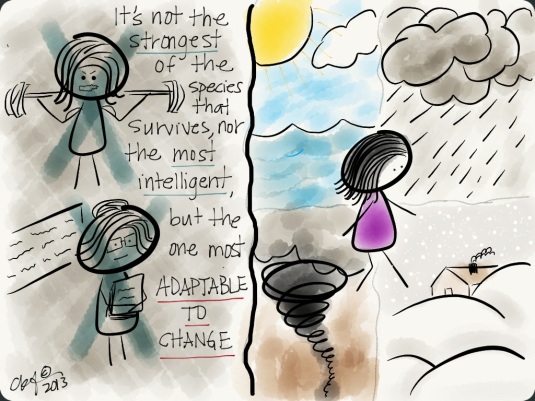
…
It’s not the strongest of the species that survives, nor the most intelligent, but the one most ADAPTABLE to CHANGE.
…
I saw this quote a few days ago and it really hit home. My life is drastically different than it was 10 years ago, even much different than it was five years ago. I will never be able to go back to the life I had so many years ago, and have to keep moving forward, toward adapting to more changes. It’s a necessary acceptance. Some of it is good, while some of it is sad. One thing for certain, though, is that change is constant.
My “normal” keeps changing. I’m sure many of you who visit or follow this blog can relate to how that feels.
Let’s keep forging ahead!
25 Apr 2013
by Fergiemoto
in Uncategorized
Tags: art, chronic pain, doodles, emotions, haiku, health, meditation, pain, poems, poetry, psychology, sketches

>>>::<<<
dark clouds swallow me
relentlessly tormenting
pain monsters
>>>::<<<
Several weeks have passed and the elevated, intense pain symptoms persist. The list of places in my body without pain is shorter than the list of places experiencing pain. This recent increase is explainable. There have been a few unexpected setbacks, and I need to continue therapy, stretches and treatments to get me back on track.
In one of my pain psychology sessions a while back, I showed my psychologist some doodles I had created, which included some emotional situations involving…of course…pain. One of the recommendations he had in addition to doing artwork regarding emotional situations is to draw an alternate scenario. For example, he asked how I would draw myself if I had more “power ” and said that drawing an alternate scenario can help you figure out an alternate in real life. So here it is…my alternate scenario:
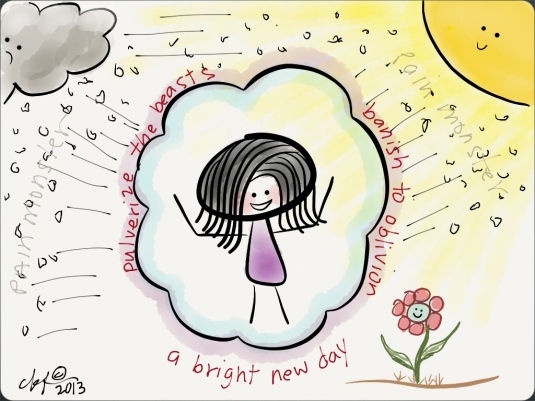
>>>::<<<
pulverize the beasts
banish to oblivion
a bright new day
>>>::<<<
Pain is only one type of monster persisting right now. What kinds of monsters are persisting (or have persisted in the past) for you?
16 Apr 2013
by Fergiemoto
in Uncategorized
Tags: art, chronic pain, doodles, emotions, haiku, health, meditation, pain, poems, poetry, psychology, sketches

>>>::<<<
pain advances
like shadows grow through the day
a new day has not dawned
>>>::<<<
Lately, there has been quite an increase in chronic pain and other symptoms. I hope for the day when decreased pain will give me some freedom and independence. In the meantime, I must continue treatments, therapy, stretches and mind/body exercises, including taking pain breaks with what I call my “nature, photography, and creativity meditation.”
20 Feb 2013
by Fergiemoto
in Uncategorized
Tags: art, creativity, doodles, emotions, encouragement, healing, health, meditation, mind/body, pain, psychology, quotes, sketches
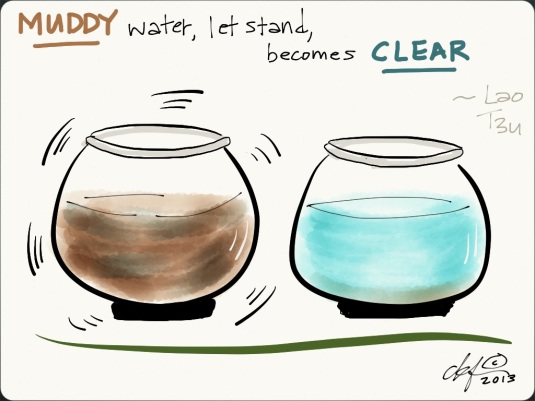
.
Muddy water, let stand, becomes clear. ~ Lao Tzu
Sometimes we just need to take a break to clear our minds or let fresh thoughts and ideas flow in. Here are just a few examples:
- If we are struggling with finding a solution to a problem, it may help to let it rest for a while. Go for a walk or do something else, and return to the problem refreshed rather than continuing to spin our wheels.
- If we are overcome by chronic physical or emotional pain, perhaps a meditative or other relaxing activity will temporarily lessen the intensity.
- If thoughts are racing through our minds, anxiety is elevated, or tempers are flying in a heated interaction, calming down can clear or minimize the turmoil.
- etc.
What are some muddy waters you have faced and what have you done to let it become clear?
08 Feb 2013
by Fergiemoto
in Uncategorized
Tags: art, creativity, doodles, emotions, encouragement, healing, health, mind/body, pain, psychology, quotes, sketches
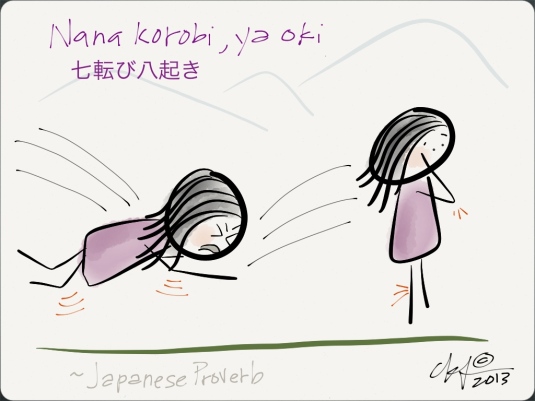
Nana korobi ya oki (七転び八起き) is a Japanese proverb that means, “seven times down, eight times up.”
nana (七) = 7
korobi (転び) = fall down
ya (八) = 8
oki (起き) = get up
It is a saying about perseverance and not giving up no matter how many times you are knocked down. I’ve seen this proverb associated with the Japanese Daruma doll, which is a hollow, round Japanese traditional doll modeled after Bodhidharma, the founder of the Zen sect of Buddhism. These dolls are weighted at the bottom in a way that will always return to an upright position when tilted over.
Never Give Up. May you always get up after a fall.
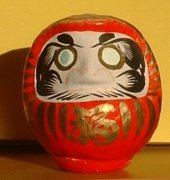
Daruma Doll
Photo courtesy: Wikipedia
20 Nov 2012
by Fergiemoto
in Uncategorized
Tags: art, emotions, haiku, healing, health, meditation, mind/body, nature, pain, photography, photos, poems, poetry, psychology
>>:::<<
a sudden rewind
engulfs me in a whirlwind
flashback
>>:::<<
Do you experience flashbacks of traumatic, sad or other painful events?
A description of flashbacks is:
a psychological phenomenon in which an individual has a sudden, usually powerful, re-experiencing of a past experience or elements of a past experience. These experiences can be happy, sad, exciting, or any other emotion one can consider. The term is used particularly when the memory is recalled involuntarily, and/or when it is so intense that the person ‘relives’ the experience, unable to fully recognize it as memory and not something that is happening in ‘real time.’ Flashbacks are the ‘personal experiences that pop into your awareness, without any conscious, premeditated attempt to search and retrieve this memory.’ (Source: Wikipedia)
I have grouped painful flashbacks as part of the “addressing emotional pain” category because I’ve learned through my pain psychology sessions that they are handled similarly to emotional pain. In previous postings, I included some of the tools that can help with painful emotions, including having an awareness of the body and how it is feeling, physically and emotionally.
Certain situations (events, places, smells, comments, time of year, etc.) can trigger flashbacks. They can be very uncomfortable and lead to feelings like fear, sadness, anxiety, panic attacks, etc. There are a few situations that trigger flashbacks for me. They can go as far as feeling anxiety, and a couple even resulted in panic attacks.
A flashback can feel very real, and your body may think it is a real event. When a flashback occurs, what are some things we can do to get through it? The key thing to remember is that the traumatic event in the flashback is not happening now even though the emotions, fears, and physical responses may be the same. Over time, the reactions to the flashbacks will diminish. Some with take more work than others. The goal is to get to the point where they are “just memories” and that’s it. Here are some things to consider:
- Breathe and practice relaxation techniques
- Allow your body to feel what is happening and have a curious acceptance about those feelings.
- Use some of the tools I’ve talked about to address emotional pain like mindfulness meditation, body awareness, guided imagery, etc. Click here to see more examples.
- Have empathy for yourself and coach yourself through it calmly and objectively. For example, some of the things I’m learning to say to myself are:
- “I wonder what this means.” (This is an important one for me because it involves seeking guidance from our inner advisor, which I’ve also posted about before.)
- “What was the trigger?”
- “I am remembering things very vividly, but it is not happening to me now.”
- “This is uncomfortable, I hate it, but I got through this before and I will get through it again.”
- “It will not kill me.”
- “I have the skills and tools to help me, and I know how to use them.”
Although coping with some of my flashbacks still need more work, there are a few that now carry no emotion, no hurt, and no anxiety if the memories occur…they have gradually become “just memories!”
If you have experienced painful flashbacks, what methods have helped you get through it?
More
16 Oct 2012
by Fergiemoto
in Uncategorized
Tags: art, chronic pain, creativity, doodles, emotions, encouragement, healing, health, pain, psychology, quotes, sketches

It does not matter how slow you go as long as you don’t stop. ~ Confucius
Many health issues over the last few years, including high chronic pain, have slowed me down significantly. In my healthy heyday, I was constantly on the go and had a good career! Now, I move very slow and am dependent on others to help stabilize me when we leave the house. I feel like I am being left behind in this fast paced world. However, I do have wonderful people closest to me who have stuck with me, supported and encouraged me in many ways, and have slowed their pace to meet mine. This is gold!
Improvements are slow but I am better than I was two years ago. During those times when things get discouraging, it’s important to remember quotes like this. Slow is not bad. It helps one appreciate the things that whizzed by before.
Even if I am moving s l o w l y, it still means there is progress. Remember the story about the tortoise and the hare? In the end, the tortoise won with slow, steady progress.
What are some profound quotes you have handy when experiencing tough times?
24 Jun 2012
by Fergiemoto
in Uncategorized
Tags: art, creativity, emotions, healing, health, mind/body, mindfulness, pain, psychology, quotes
To see things in the seed, that is genius. ~ Lao Tzu
In a previous post I listed some tools to help address emotional pain. One of those tools I learned is creating artwork that represents what you are feeling, such as a drawing, painting, sketching, doodling, photography, etc. It doesn’t have to be fancy and you don’t have to be an artist. The important point to remember is that the energy associated with painful emotions needs an outlet, instead of becoming trapped in the body. Just try to get it out of you. Stopping, distracting, dismissing or suppressing these emotions can surface later in other, potentially harmful ways.
When you create your “emotion” artwork, ask yourself a couple of questions. “What does this picture mean?” “What is it trying to tell me?” It may depict a primary feeling at first, such as sadness, anger, fear, etc. But try to dig deeper and notice other feelings that arise. Don’t be content with the first emotion you are creating because this could help reveal core issues that need to be addressed.
Look at the following doodle for example. Have you ever felt down or discouraged, like you were in a deep hole and didn’t know how to climb out? If this were one of your doodles, what are your initial feelings? Is it hopeless, overwhelmed…? If you dig deeper, what are other feelings that arise? List them…is it sad…lonely…frustrated…angry…isolated…irritated, etc…? The face may not depict all the emotions, but dig deeper. Notice what else you are feeling. More
14 Mar 2012
by Fergiemoto
in Uncategorized
Tags: alternative medicine, chronic pain, emotions, healing, health, mind/body, pain, psychology
Baby steps…toddler steps…sometimes this is the pace we have to take to achieve our end goals and desires. Overcoming any kind of struggle can be very daunting, frustrating and discouraging, and setting large goals can seem overwhelming. They require patience that sometimes we don’t think we have anymore. It’s easy to get over-ambitious and all too often, we are looking for an overnight success, which is understandable. In the meantime, we overlook and neglect the small accomplishments that lead to larger victories. Busy schedules can bog us down; pain can seem to overtake our entire waking moments that we wonder if there is ever an end; then we miss the chance to celebrate those wins. Progress is good at any level because it means we are headed in the right direction. I realize this is easier said than done. Believe me, I’ve been there many times.
When you have a success, do you say a quick “yay”, move on as if nothing special happened, and then rarely or never give it another thought? The next time you have a success, remember this: Recognize…Reward…and Celebrate! You are working hard to reach your goal, so don’t brush it aside. The body and mind need the reinforcement and encouragement. When you celebrate, you are helping to breed an attitude of “I’m successful” to your mind, which will then breed more success. One success leads to another to another and hopefully you will accelerate the process of reaching your goals, i.e., the snowball effect. Mental health affects physical health. More
23 Feb 2012
by Fergiemoto
in Uncategorized
Tags: alternative medicine, emotions, healing, health, meditation, mind/body, mindfulness, pain, psychology
Knowing others is wisdom; Knowing the self is enlightenment; Mastering the self is true power. ~ Lao Tzu
Recognizing our primary and secondary emotions helps us understand what our core emotions and issues are. I talked a little about core issues in my previous post on body awareness. Simply, secondary emotions occur in response to a primary emotion. Eventually we may unknowingly bury our primary emotions until they are unrecognizable. The problem with this is that we may think our secondary emotions are what we are really feeling, and address those, rather than addressing the true and primary emotions.
Anger is a good example of a secondary emotion. Anger is usually a response to a primary emotion or situation. When we get behind our anger, we may discover that there is a different emotion at the core, such as shame, fear, worry, guilt, embarrassment, regret, sadness, loneliness, etc. Anger, although an intense emotion, is more acceptable and easier to admit to than showing vulnerability. If a primary emotion is shame, people usually don’t want to admit to shame, so they may respond with anger instead. Some will want to push back for safety, and get away from the true emotion with a few sharp words of anger.
Irritability can be a similar response to anger. It is usually a secondary emotion (other than hormonal). What about anxiety? It could be a secondary emotion to fear.
If we don’t address our primary emotions, they likely won’t go away. We may not express them for a variety of reasons, such as habit, upbringing, social situations, etc. Therefore, secondary emotions may end up hindering us because we are not addressing the real issue, nor are we expressing them appropriately. Also, we probably won’t be able to understand what our primary emotions are without understanding how to use self-awareness tools, some of which I have talked about in this blog. Tools such as body awareness, mindfulness meditation, emotion focus therapy, guided imagery, downward arrow exercise, and so on, really help us listen to our bodies and feelings. You may have a different tool that you have found to be effective for you. Something to keep in mind is to keep asking yourself, “what am I feeling…what else am I feeling…what else…what else?”
It’s like deconstructing a recipe. When you taste something, there is an interplay of ingredients that make up the overall taste. But savor the flavors and notice the individual tastes and sensations. What’s making up the taste? For example, you may find that you taste cinnamon, pepper, lemon, etc. So..…what’s really making up your emotions? Try to deconstruct it and see what you find.
Don’t always be comfortable with your first emotion. Try to find out what it is really about. Recognizing deeper emotions can be very helpful part of a healing process!
Related articles:
12 Feb 2012
by Fergiemoto
in Uncategorized
Tags: art, emotions, haiku, health, mind/body, nature, pain, photography, photos, poems, poetry, psychology
>>:::<<
Vicissitudes swarm
Thriving on a carousel
Dreams evaporate
>>:::<<
Finch: “What!? The other birds didn’t leave me any birdseed. Bummer! That’s discouraging.”
(Chronic ailments holding you back, leaving you feeling isolated? Healing taking a long time? Struggles visit unexpectedly or overstaying their welcome? Many situations can leave a person feeling discouraged.) I’m using one of my artwork “tools” again to help address emotions. See my posting on Addressing Emotional Pain #2 – Tools.
Related article:
Other postings in my “Emotion:” series:
30 Jan 2012
by Fergiemoto
in Alternative Medicine
Tags: alternative medicine, art, emotions, haiga, haiku, health, mind/body, mindfulness, pain, photography, poetry, psychology

Today, I expand on my earlier postings on body awareness as a tool for addressing emotional pain. I’ve learned many important and enlightening things during my treatment sessions, which I share here…and yes, they are helping.
- “Emotion Focus Therapy” – Becoming more aware of the complexity and nature of feelings.
- “Mindfulness” – Noticing what you are feeling and where you are feeling certain emotions in the body.
- Emotion Focus Therapy and Mindfulness go hand in hand. You have to be mindful of the body to identify what emotions are present.
- Identifying emotions combined with body awareness helps get to the core of issues and feelings. Understanding emotions helps to realize what needs changing so they don’t persist and perpetuate a problem in the body.
- Body awareness helps address and process emotions, and gives the associated energy an outlet.
- Gradual exposure to an emotion, such as with body awareness, will lessen the intensity and lead to a greater understanding of what is happening.
- Emotions can motivate people to take action and address them.
- Every emotion has a corresponding physical manifestation. This means that there is some sensation in the body occurring at the same time as the emotion (“I’m so sad my heart hurts.” “I’m so angry my stomach is churning” etc.). There can also be a chemical change in the body. Hence:
- The mind and body are connected. They are in harmony to protect you and are not fighting against each other. “Dualism is dead!”
- Remember, “It’s natural to have emotional ups and downs,” per Dr. Andrew Weil on Spontaneous Happiness. More
10 Jan 2012
by Fergiemoto
in Uncategorized
Tags: alternative medicine, chronic pain, emotions, healing, health, invisible illness, pain, psychology
”Tears expand you, they don’t diminish you.” ~ Michael Ondaatje
“We are expanded by tears, not reduced by them.” ~ anon
I’ve learned many important things about pain, physical and emotional, in my various treatment sessions over the last year and a half. I will share more of them here and in later postings.
If you experience pain, have you heard things like: “It’s all in your head.”; “It’s psychological.”; “You have a low tolerance for pain.”; “You’re not handling pain very well.”; “Pull yourself together and quit complaining.”; “Tough it out.”; “Quit crying.”; etc.
If so, how did that make you feel? Did you feel like it was an attempt to minimize what you are experiencing, or that the person didn’t care about how you were feeling? In my opinion, those and similar statements would hinder communication and trust at a time when support and encouragement are needed. Did you feel like you were weak and that you needed to be a “stronger” person? Read the quote at the top of this post again. More
03 Jan 2012
by Fergiemoto
in Alternative Medicine
Tags: acupuncture, alternative medicine, chronic pain, creativity, healing, health, massage therapy, meditation, mind/body, pain, psychology
The best way out is always through. ~ Robert Frost
If you are going through hell, keep going. ~ Winston Churchill
If you are a chronic pain sufferer, you probably have days that are more of a struggle than others. Some even seem impossible to get through, but fortunately, those days are getting fewer and fewer for me.
There are many ways to address physical pain, chronic or not, but with helpful guidance from my healers, here are techniques and exercises I have learned. The exercises are much easier said than done, but practice helps.
- Meditation – This includes “mindfulness meditation.” Meditation helps with relaxing which can help decrease pain.
- Have someone to confide in 100% – Talking it out or leaning on a compassionate shoulder can be very helpful. To be effective, that person needs to give you their full attention and genuinely want to listen.
“We can live without religion and meditation, but we cannot survive without human affection”. ~ Dalai Lama
- Body awareness – As explained to me, “sometimes the way out of pain is to go right through it.”
- Be in the “moment” – Give yourself a break and be in the present. For that time, don’t think about what might happen in the future, or think “what if this never goes away”. Don’t think about how difficult the road to the present has been.
- Gather Moments – Rewind through the activities of a a particularly bad day to find the good things that happened. Write it down and soon you will have a “bouquet of moments” to recall for other challenging days.
- Celebrate the small successes – It’s important to recognize and reward progress.
More











